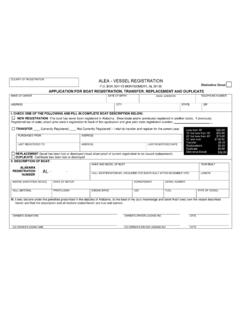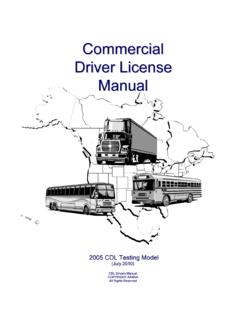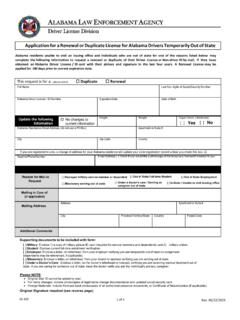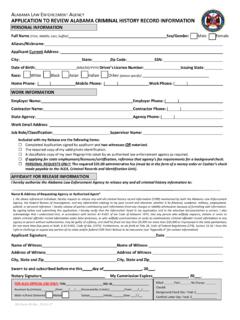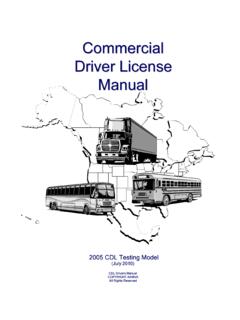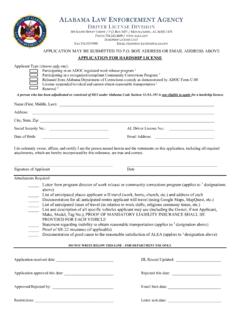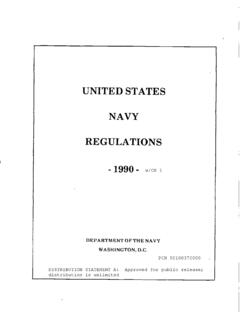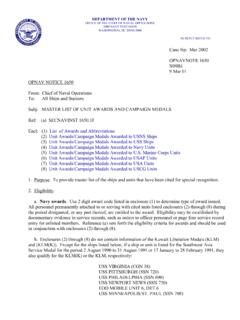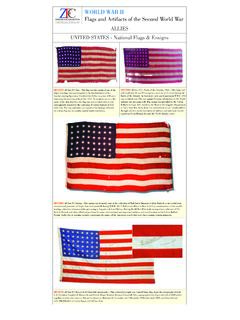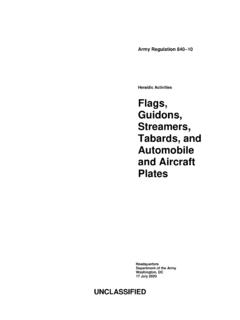Transcription of Boat Certification Manual - ALEA
1 Certification MANUALSPONSORED BY2017 EDITION AL 3717 ZWALEA Marine Patrol DivisionCopyright 2017 Kalkomey Enterprises, LLC and its divisions and partners, Alabama Boater:The Roberson/Archer Act passed by the Alabama Legislature in 1994 requires boater Certification for all operators of motorized vessels. The Act was named in memory of three Alabama children Lauren Archer, age 4, and Katey and Ashleigh Roberson, ages 5 and 9, who were tragically killed in boating accidents in 1993. Their deaths and a crusade by their families led to the passage of the Act, which has been widely acclaimed as a national model for boating safety Manual is designed to assist you in achieving two primary objectives: (1) to help you qualify for Alabama boat operator s Certification and (2) to help you become a better informed and safer operator. The information contained in this Manual is not intended to be an official legal reference for all boating laws and regulations.
2 It is intended to explain in common language those laws, regulations, and boating practices you will need most often. In addition, the procedure for obtaining your boat operator s Certification is Patrol troopers patrol our waterways to make your boating experience safe and pleasant. Cooperate with them while operating your boat by following the suggestions outlined in this Manual as well as the rules of common courtesy. Sincerely, Major Walter S. Thompson, Chief Marine Patrol Division Copyright 2017 Kalkomey Enterprises, LLC and its divisions and partners, MANUALS ponsored by ALEA Marine Patrol Box 304115 Montgomery, AL 36130 334-517-2950 Major Walter S. Thompson, ChiefPublished by boat Ed , a division of Kalkomey Enterprises, LLC, 14086 Proton Road, Dallas, TX 75244, 214-351-0461. Printed in the Copyright 2003 2017 by Kalkomey Enterprises, LLC. All rights reserved. No part of this publication may be reproduced in any form or by any process without permission in writing from Kalkomey Enterprises, LLC.
3 Effort has been made to make this publication as complete and accurate as possible. All references contained in this publication have been compiled from sources believed to be reliable, and to represent the best current opinion on the subject. Kalkomey Enterprises, LLC is not responsible or liable for any claims, liabilities, damages, or other adverse effects or consequences to any person or property caused or alleged to be caused directly or indirectly from the application or use of the information contained in this publication. ALEA Marine Patrol Division does not discriminate on the basis of race, color, religion, age, gender, national origin, or disability in its hiring or employment practices nor in admission to, access to, or operation of its programs, services, or 2017 Kalkomey Enterprises, LLC and its divisions and partners, k e t h e D e p a r t m e n t o f P u b l i c S a f e t y D r i v e r s License Division Certification ExamIf you choose to obtain your Alabama boater safety Certification by taking the exam given by the Alabama Department of Public Safety Driver s License Division, you should:1.
4 Study this Manual to prepare for the Go to the Department of Public Safety Driver s License Examining Office in your county of residence to take the 25-question exam. You will be required to present personal Upon passing (answering 20 of the 25 questions correctly), apply for your Alabama boater safety Certification . You will have the V class placed on your automobile driver s license. Or, if you do not have an automobile driver s license, you will be issued a Vessel Only license. the Online Course and Certification ExamYou can take an approved boating safety course online at passing the online exam, you will be mailed a course certificate from the ALEA Marine Patrol. Take this certificate and personal identification to the Department of Public Safety Driver s License Examining Office in your county of residence to have the V class placed on your automobile driver s license. Or, if you do not have an automobile driver s license, you will be issued a Vessel Only license.
5 Stay up to date on new boating laws!For state boating law information, call the DPS-Marine Patrol Division at 334-517-2950 or visit For federal boating laws, visit the Coast Guard s boating safety website at: in this Manual does not replace what is specifically legal for boating in Alabama, which is found in Alabama Code and federal laws. Every person who operates a motorized vessel on Alabama s waterways must have obtained Alabama boater safety Certification . You may obtain Alabama boater safety Certification by showing valid proof of passing an approved boating safety course (see page 14) or by passing a Certification exam given by the Alabama Department of Public Safety Driver s License Division. This Manual is designed to prepare you to take the certifica-tion exam given by the Alabama Department of Public Safety Driver s License to Use This ManualCopyright 2017 Kalkomey Enterprises, LLC and its divisions and partners, Safety CertificationAge and Boater Certification Requirements for Operators.
6 12 How to Obtain Boater Certification ..14 Other Facts About Boater Certification 15 Required Equipment Personal Flotation Devices ..16 Fire Extinguishers ..17 Navigation Lights ..18 Ventilation Systems ..19 Backfire Flame Arrestors ..19 Mufflers and Noise Level Limits ..20 Sound-Producing Devices ..20 Other Equipment ..21On the WaterUnlawful and Dangerous Operation ..22 Obstructing Navigation ..23 Homeland Security Restrictions ..23 Enforcement ..23 Boating Accidents ..24 Alcohol and Drugs ..24 Disposal of Trash, Garbage, or Plastics ..25 Specifically for PWCsLegal Requirements Specific to PWCs ..26 Specifically for SkiingLegal Requirements for To w i n g S k i e r s ..27 Before Going OutVe s s e l L e n g t h C l a s s e s ..2 Vessel Capacity ..2 Fueling a Vessel ..2 Additional Safety Procedures for PWCs ..3 Filing a Float Plan ..3 Pre-Departure Checklist ..3On the WaterEncountering Other Vessels ..4 Encountering Vessels With Limited Maneuverability.
7 4 Navigation Rules ..4 Nighttime Navigation ..5 Encountering Vessels at Night ..6 Encountering a Sailboat at Night .. Aids to Navigation System ..6 Lateral Markers ..6 Non-Lateral Markers ..8 Weather Emergencies ..9 VHF Channels for Recreational Boaters ..9 What to Do if Caught in Foul Weather ..9 Other Boating Emergencies ..10 Falling Overboard ..10 Capsizing or Swamping ..10 Hypothermia ..10 Carbon Monoxide Poisoning ..11 Preventing Theft ..11 BOATINGIT'S THETa b l e o f C o n t e n t s1 Copyright 2017 Kalkomey Enterprises, LLC and its divisions and partners, going out on the water, take steps to make the outing safe and Length Classes A vessel s length class dictates the equipment necessary to comply with federal and state laws. Ve s s e l s a r e d i v i d e d i n t o f o u r l e n g t h c l a s s e s : Less than 16 feet 16 feet to less than 26 feet 26 feet to less than 40 feet 40 feet to less than 65 feet Length is measured from the tip of the bow in a straight line to the stern.
8 This does not include outboard motors, brackets, rudders, bow attach-ments, or swim platforms and ladders that are not a molded part of the Capacity Always check the capacity plate usually found near the operator s position or on the vessel s transom. This plate indicates the maximum weight capacity and maximum number of people that the vessel can carry safely. Personal watercraft (PWCs) and some other vessels do not have a capacity plate. Always follow the recommended capacity in the owner s Manual and on the manufacturer s warning a VesselNever fuel at night unless it is an emergency. If you must refuel after dark, use only electric lights. Try to refuel away from the water or on a commercial fueling ramp. Before beginning to fuel: Dock the boat securely and ask all passengers to exit. Do not allow anyone to smoke or strike a match. Check all fuel lines, connections, and fuel vents. Turn off anything that might cause a spark engines, fans, or electrical equipment.
9 Shut off all fuel valves and extinguish all open flames, such as galley stoves and pilot lights. Close all windows, ports, doors, and other openings to prevent fumes from entering the boat . Remove portable fuel tanks and fill them on the most important safe fueling your vessel is equipped with a power ventilation system, turn it on for at least four minutes after fueling and before starting your engine to remove gas Going OutCopyright 2017 Kalkomey Enterprises, LLC and its divisions and partners, Basics 3 While filling the fuel tank: Keep the nozzle of the fuel-pump hose in contact with the tank opening to prevent producing a static spark. Avoid spilling fuel into the boat s bilge or the water. Never fill a tank to the brim leave room for gas to expand. After fueling: Wipe up any spilled fuel. Open all windows, ports, doors, and other Safety Procedures for PWCs Do not tip the PWC in order to fill it all the way up.
10 If the tank is overfilled, the fuel may expand and spill into the water. After fueling, open the door of the engine compartment and sniff to check for any evidence of gas fumes. Do this before starting the engine. If you do smell gas fumes, determine the source and make repairs a Float PlanBefore going out on a vessel, it is always a good idea to leave a float plan with a relative or friend, or at least with a local marina. A float plan should: Describe the vessel, including its registration number, length, make, horsepower, and engine type. State where you are going, the detailed route, your planned departure time, and your expected return time. Give the name, address, and telephone number of each person on board and an emergency contact. Pre-Departure ChecklistYou can help assure a good time while operating your vessel by performing this pre-departure check. Check the weather forecast for the area and timeframe during which you will be boating.
